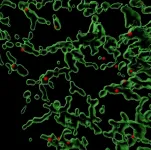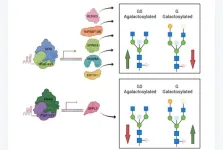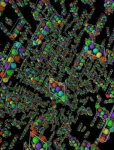(Press-News.org) Seismic events that coincided with sudden drops in pressure within the Nord Stream 1 and 2 natural gas pipelines in September 2022 alerted the world to the rupture of pipelines in the western Baltic Sea. The suspected act of sabotage, which reportedly used explosive charges to rupture the pipelines, is still under investigation by multiple countries.
A new study published in The Seismic Record provides further evidence that the Nord Stream seismic signals came from a complex source. The signals lasted longer than would be expected from a single explosive source, the researchers say, and were more like the signals detected from an underwater volcano or a pipeline venting gas.
The initial signals from seismic events detected on 26 September 2022 “may be dominated by energy generated by the rapid venting of high-pressure gas, which means it may be difficult to assess the source size and characteristics of any explosive charges used to rupture the Nord Stream pipelines,” said Ross Heyburn of AWE Blacknest.
The Nord Stream events offer a rare opportunity to study seismic and infrasound signals from the rupture of an underwater gas pipeline, Heyburn and colleagues noted. The researchers had access to data collected by local and regional seismic networks as well as seismic and infrasound data collected by the International Monitoring System (IMS), a global network that detects nuclear and other explosions for the Comprehensive Nuclear-Test-Ban Treaty Organization (CTBTO).
“To the best of our knowledge, this was the first time that the IMS has recorded signals from an underwater event associated with a gas pipeline rupture,” Heyburn said. “The events therefore provided an opportunity to observe the characteristics of signals, such as the long durations, generated by this type of source.”
Natural seismic activity in the region is low, but the research team was able to analyze the Nord Stream signals with the help of seismic data from a few small earthquakes and explosions detonated during a 2019 NATO operation in the region to clear World War II British ground mines.
One of the methods seismologists use to determine whether a seismic event is caused by an explosion or an earthquake is to measure the ratio of P to S waves for the event. Explosions usually have a higher ratio of P to S waves than earthquakes, and the Nord Stream events are very different to nearby earthquakes in this regard, the researchers concluded.
The spectra of seismic signals from underwater explosions sometimes display a series of modulations caused by interference between the primary pulse generated by the explosion and later pulses generated by the changing size of the gas bubble created by the explosion. Heyburn and colleagues did not observe this series of modulations clearly, which suggests a complex source rather than a simple explosion source for the Nord Stream events.
One of the most striking features of the Nord Stream events is its long-lasting seismic and infrasonic signals, the researchers found. These signals decay slowly over thousands of seconds—much longer than would be expected from an impulsive, single explosion event. For instance, the infrasound recorded in Southern Germany from the first Nord Stream event of 26 September lasted about 2000 seconds, while an impulsive event recorded at that distance would normally last no longer than about 600 seconds.
These long-lasting seismic and infrasound signals are likely the result of vibrations caused by high-pressure gas venting rapidly from the pipeline into the water and atmosphere. The lengthy signals are similar to seismic signals caused by roaring flames when pipelines explode on land, Heyburn and colleagues concluded, noting that the duration of the Nord Stream infrasound signals was similar to those detected during venting by underwater volcanoes.
The researchers also compared the magnitude of the first Nord Stream pipeline seismic event to the magnitude of a seismic event on 7 October 2023 caused by the underwater rupture of the Balticconnector gas pipeline connecting Finland and Estonia. The Balticconnector pipeline rupture is thought to have been caused by a ship’s anchor rather than an explosive charge.
The difference in seismic magnitudes between the two events “is consistent with the estimated potential energy ratio of the gas in each of these pipelines,” Heyburn explained, which suggests that seismoacoustic signals from the initial Nord Stream event were dominated by the rapid venting of high-pressure gas.
END
Seismic and infrasonic signals used to characterize Nord Stream pipeline events
2024-01-03
ELSE PRESS RELEASES FROM THIS DATE:
Surprise! – How the brain learns to deal with the unexpected
2024-01-03
For children, the world is full of surprises. Adults, on the other hand, are much more difficult to surprise. And there are complex processes behind this apparently straightforward state of affairs. Researchers at the University of Basel have been using mice to decode how reactions to the unexpected develop in the growing brain.
Babies love playing peekaboo, continuing to react even on the tenth sudden appearance of their partner in the game. Recognizing the unexpected is an important cognitive ability. After all, new can also mean dangerous.
The exact way in which surprises are processed in the brain changes as we grow, however: unusual ...
Genetic variants underlying male bisexual behavior, risk-taking linked to more children, study shows
2024-01-03
ANN ARBOR—Because same-sex sexual behavior does not result in offspring, evolutionary biologists have long wondered how the genes associated with this behavior have persisted in the human genome, and whether they will remain in the future.
A new University of Michigan-led study, scheduled for publication Jan. 3 in the journal Science Advances, suggests that part of the explanation—specifically for male bisexuals—has to do with risk-taking behavior.
The U-M researchers analyzed data from more than 450,000 participants of European ancestry in the United Kingdom's Biobank database of genetic and health information. Participants responded to a questionnaire ...
Shining a light on the hidden damage of mild brain injuries
2024-01-03
Researchers have created a new brain imaging method that allows mild traumatic brain injuries (mTBIs) to be diagnosed, even when existing imaging techniques like magnetic resonance imaging (MRI) don’t show any structural abnormalities. The technique involves loading gadolinium, a standard MRI contrast agent, into hydrogel-based micropatches that are attached to immune cells called macrophages. mTBIs cause inflammation in the brain, which produces signals that attract macrophages to migrate there. Coupling the gadolinium contrast agent to these cells enables MRI to reveal ...
Weill Cornell Medicine receives grant for blood test to diagnose breast cancer
2024-01-03
Weill Cornell Medicine researchers received a $2.4 million grant from the U.S. Department of Defense Breast Cancer Research Program to validate a new blood test for the early detection of breast cancer.
Researchers are evaluating Syantra DX Breast Cancer (Syantra Inc.), an experimental diagnostic test that detects specific biomarkers in blood associated with breast cancer. The test uses an artificial intelligence algorithm to determine whether a patient is positive for cancer as soon as detectable by mammogram or possibly earlier, and before symptoms arise.
“This new liquid biopsy, ...
Using the body’s own cells to treat traumatic brain injury
2024-01-03
Scientists have created a new treatment for traumatic brain injury (TBI) that shrank brain lesions by 56% and significantly reduced local inflammation levels in pigs. The new approach leverages macrophages, a type of white blood cell that can dial inflammation up or down in the body in response to infection and injury. The team created disc-shaped microparticles called “backpacks” containing anti-inflammatory molecules, then attached them directly to the macrophages. These molecules kept the cells in an anti-inflammatory state ...
UW–Madison scientists reveal the inner workings of an essential protein trafficking complex
2024-01-03
MADISON – Like mail carriers who manage to deliver their parcels through snow, rain, heat and gloom, a critical group of mammalian proteins helps cells function properly even under less-than-ideal conditions.
Using state-of-the-art cell imaging and genome editing technology, University of Wisconsin–Madison scientists have begun to unravel how this collection of proteins performs its essential service. The discovery could eventually help researchers better understand and develop new treatments for diseases like cancer, diabetes and those that cause immune dysfunction.
Led by Anjon Audhya, a professor in the Department of Biomolecular Chemistry, the research team sought ...
Mapping of the gene network that regulates glycan clock of ageing
2024-01-03
“[...] we were able to confirm the functional role of three genes (MANBA, TNFRSF13B and EEF1A1) in the IgG galactosylation pathway [...]”
BUFFALO, NY- January 3, 2024 – A new research paper was published in Aging (listed by MEDLINE/PubMed as "Aging (Albany NY)" and "Aging-US" by Web of Science) Volume 15, Issue 24, entitled, “Mapping of the gene network that regulates glycan clock of ageing.”
Glycans are an essential structural component of immunoglobulin G (IgG) that modulate its structure and function. However, regulatory mechanisms behind this complex posttranslational ...
Computational method discovers hundreds of new ceramics for extreme environments
2024-01-03
DURHAM, N.C. – If you have a deep-seated, nagging worry over dropping your phone in molten lava, you’re in luck.
A research team led by materials scientists at Duke University has developed a method for rapidly discovering a new class of materials with heat and electronic tolerances so rugged that they that could enable devices to function at lava-like temperatures above several thousands of degrees Fahrenheit.
Harder than steel and stable in chemically corrosive environments, these materials ...
Community cancer care linked with poorer outcomes for patients with a common head and neck cancer
2024-01-03
FOR IMMEDIATE RELEASE
Care for patients with human papillomavirus (HPV)-related squamous cell cancers of the oropharynx (an area in back of the throat) is shifting toward community cancer centers, but patients treated in this setting may be less likely to survive, according to new research by investigators from the Johns Hopkins Kimmel Cancer Center and its Head and Neck Cancer Center.
The study, published Jan. 3 in the Journal of the National Cancer Institute, raises concerns about the quality of care that patients with this type of head and neck cancer receive outside of academic medical centers. Patients treated ...
Beta blocker used to treat heart problems and other medical concerns could be new treatment for sickle cell cardiomyopathy
2024-01-03
INDIANAPOLIS—A beta blocker typically used to treat heart problems, hemangioma, migraines and anxiety could be a new therapeutic for patients with sickle cell disease. Researchers led by Ankit A. Desai, MD, associate professor of medicine at the Krannert Cardiovascular Research Center (KCVRC) at Indiana University School of Medicine, have been awarded a $3 million grant by the U.S. Department of Defense to evaluate the efficacy of this drug.
Patients with sickle cell disease, a red blood ...


